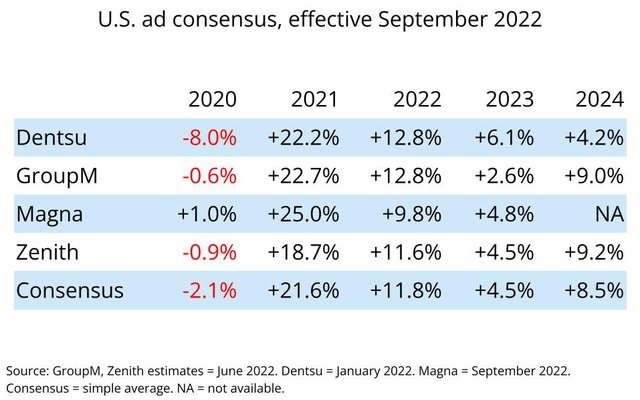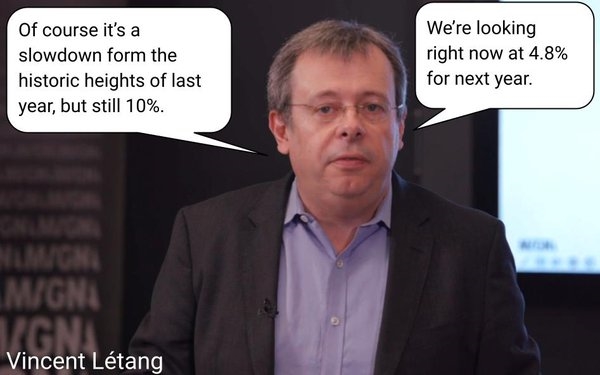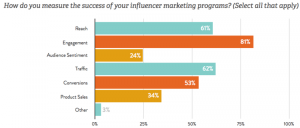IPG’s Magna Reduces U.S. Outlook, Cites Economic Slowdown

IPG Mediabrands’s Magna this morning becomes the latest of the Big 4 holding company forecasting units to lower U.S. ad growth expectations for this year and next, due mainly to the slowdown in the U.S. and global economies.
Magna reduced its 2022 growth estimate three-tenths of a point to 9.8% from the 11.1% expansion it forecast in its last update in June, and it reduced its 2023 ad-growth forecast 5.4 points to 4.8%, from 10.2% in June.
Magna’s downward revision brings the Big 4 consensus estimate for U.S. ad expansion down to 11.8% from 12.1% when Dentsu released its update in July. The consensus outlook for 2023 has been revised down to a 4.5% expansion from 5.9%.
“Of course it’s a slowdown form the historic heights of last year, but still 10%,” Magna Executive Vice President of Global Market Intelligence Vincent Letang said in a presentation provided to the press, adding that 2023’s big downward adjustment is due to the combination of weakening economies, as well as the lack of the kind of “cyclical events” — the Winter Olympic Games, World Cup Soccer, and the midterm elections — that will add upwards of $10 billion in incremental ad spending to the U.S. economy this year.
In his analysis of shifts in major media spending, Letang noted that “social media is the media type that is struggling this year,” projecting it will rise a relatively tepid rate — roughly half the overall U.S. ad growth rate — due mainly to its “maturity,” as well as the impact that Apple’s privacy framework has had on the ability of social apps to target and reach identifiable consumers.
“Overall, we anticipate social ad revenues to grow by 4% to $63 billion this year,” he said, adding: “With rapid growth of TikTok and almost no growth from incumbent social networks.”
The most ascendant medium will be out-of-home, which has recovered from the impact of the COVID-19 pandemic, and is projected to rise 21.8% this year.
But search also is projected to rise 17.1%, and Letang attributed much of that growth to the rise of search on retail media networks vs. more mature search engines like Google.
Letang’s insight about the rising role of retail media networks in the overall advertising economy comes a week after rival GroupM benchmarked retail media ad spending at more than $100 billion currently, with projections that it could rise to $160 billion within a few years.
“Search, already the largest ad format, will grow by 17% this year to reach $116 billion,” Letang explained about his projections, adding: “Keyword-based formats are intrinsically immune from the restrictions to database targeting and now grow much beyond traditional search engines like Google though retail media networks — that’s Amazon, primarily, but every other large retailer is now engaged in developing advertising sales through those retail media networks.”

(11)
Report Post



